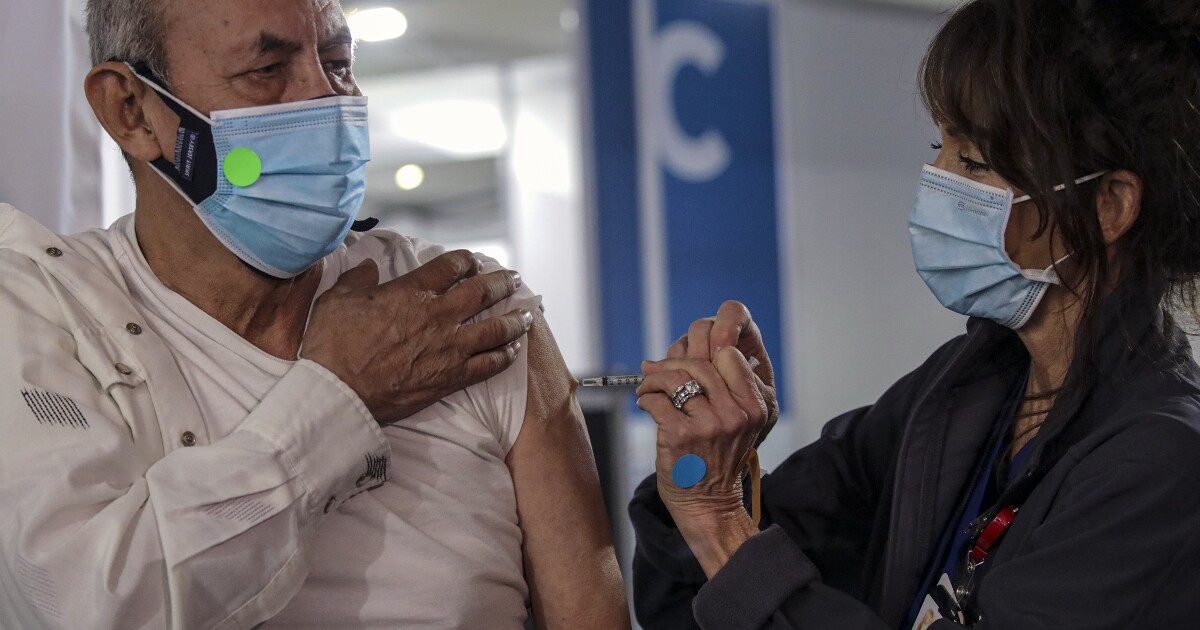The chance to get the first dose of a COVID-19 vaccine will be very valuable in Los Angeles County next week, as a continuing supply crisis and a queue of people who need a second injection will leave little opportunity for those who wish start their vaccines, a senior health official said on Friday.
Most consultations offered at major vaccination sites administered by the county will be required for second doses, according to Dr. Paul Simon, director of science for the LA County Department of Public Health. At the county’s five mega-PODs, or mass distribution points, only a very limited number of people will be able to receive their first doses on Monday.
“We are just struggling with the supply, the limited supply, and feeling an obligation to ensure that the people who received the first dose can receive the second,” he said during a briefing. “But we know, just based on the numbers, that next week at least on our websites, in addition to Monday, we really have to keep the second doses. When we get to the next week, the story may be a little different if we can get a bigger supply of a vaccine. But we will have to wait and see. “
In the face of limited and inconsistent supplies, the county is reserving enough doses to ensure there is enough for everyone who has already received their first injection of the Pfizer-BioNTech or Moderna vaccines.
Both vaccines require two injections, given three and four weeks apart, respectively.
Because of this, residents receiving the initial dose need to return to the queue weeks later. When the county’s total vaccine supply remains stable, or declines, it leaves little room for maneuver to also deliver the first doses.
In LA County, 193,950 doses arrived in the week of January 11, but only 168,575 were delivered the following week and 146,225 the following week.
County officials said 184,625 doses arrived this week. Despite an increase from last week’s total, shipments need to be much larger to meet demand and allow additional groups of Angelenos to receive their first doses.
“If we keep getting more and more supplies, we will obviously be able to expand and continue to deliver the first few doses,” said Simon. “We certainly want to do that.”
Cumulatively, more than 1 million doses of the COVID-19 vaccine have been administered in LA County and nearly 850,000 people – or about 11% of the population aged 16 and over – received the first doses. Approximately 2.6% of Angelenos in this age group are fully vaccinated.
The bottleneck is not unique to LA County. Regions across California have reported similar problems and have had to take similar steps to ensure that people don’t miss the second chance.
First-dose clinics have been disrupted in Napa County, while authorities have been updated on the application of the second vaccine.
“While it’s amazing that the vaccine is here now, we just don’t have enough,” said Dr. Karen Relucio, public health officer for Napa County. “Supplies are unpredictable. We are operating with narrow margins ”.
So far, more than 4 million doses of the COVID-19 vaccine have been administered throughout California.
According to the Centers for Disease Control and Prevention, nearly 7 million doses of the vaccine have been shipped and 6.8 million have been delivered to health providers in the state. That is, almost 62% of the available stock has already been used.
Authorities said the state expects vaccine allocation of more than 1 million doses next week, and a similar amount the following week. Previously, the state had received about 300,000 to 500,000 doses per week.
Supply, while increasing, remains low compared to what is needed and eligibility is limited. California health departments are currently able to administer vaccines to healthcare professionals, first responders, employees and residents of long-term care facilities such as nursing homes and adults at least 65 years of age.
They also have the option of distributing doses to those working in the areas of education, emergency services and food and agriculture – but many counties have not yet opened eligibility for these groups due to supply restrictions.
LA County, for example, is accepting appointments only for healthcare professionals, residents of long-term care facilities and adults at least 65 years of age.
Together, these groups comprise about 2 million people, meaning that 4 million doses would be needed to fully vaccinate those who are currently eligible – not to mention the millions of other angelenos who have yet to be inoculated.
“Unfortunately, the biggest problem we continue to face in our ability to vaccinate is the scarcity of supply and the variability in the number of vaccines we receive from week to week,” said Simon. “This has been a problem across the country and makes planning very challenging.”
Times staff writer Faith E. Pinho contributed to this report.
